Table of Contents
Introduction
According to Smarter Devices Statistics, Smarter devices encompass many technologically advanced gadgets vital to the Internet of Things (IoT) world. These devices are known for their connectivity, automation capabilities, data-gathering abilities, and intelligence. They include smartphones, smart home gadgets, wearable tech, connected vehicles, and industrial IoT tools.
They offer advantages such as convenience, increased efficiency, cost savings, safety improvements, and health-related benefits. However, they also come with privacy concerns, security risks, compatibility issues, and energy usage.
The market for smarter devices is rapidly expanding due to growing consumer interest and technological advancements, with future trends emphasizing 5G connectivity, edge computing, and personalized experiences driven by AI. As these devices continue to develop, they have the potential to transform how we engage with technology and have a significant impact on various industries.
Editor’s Choice
- In 2022, the worldwide smarter device market will have an estimated worth of about $49.04 billion, and it will likely reach approximately $150 billion by 2030.
- It’s expected to see an average annual growth rate of around 15% during this period.
- As of 2022, an estimated 6.5 billion smartphone subscriptions were actively used, expected to climb to nearly eight billion by 2028.
- In 2023, the global shipment total for smart home devices amounted to approximately 857 million units, with a significant portion of these, around 278 million units, falling within the video entertainment category.
- Predictions point to a remarkable growth in the total count of IoT devices across all industries, reaching beyond eight billion by 2030.
- 49% of individuals who utilize connected devices have faced at least one data security or privacy issue.
- According to research by Parks Associates, 72% of consumers express varying levels of concern, with many being very concerned about the security of their data collected and transmitted by devices.
Global Smarter Devices Market Overview
- In 2022, the worldwide smart device market had an estimated worth of about $49.04 billion, and experts predict that it will likely reach approximately $150 billion by 2030.
- It’s expected to see an average annual growth rate of around 15% during this period.
- In 2020, the most prominent category within this market was wrist-worn devices, making up more than 48.9% of the total market share.
- From 2021 to 2028, the eyewear and headwear product segment is forecasted to grow at a compounded annual growth rate (CAGR) of 14.2%.
- In 2020, North America was at the forefront, accounting for over 34.7% of global sales.
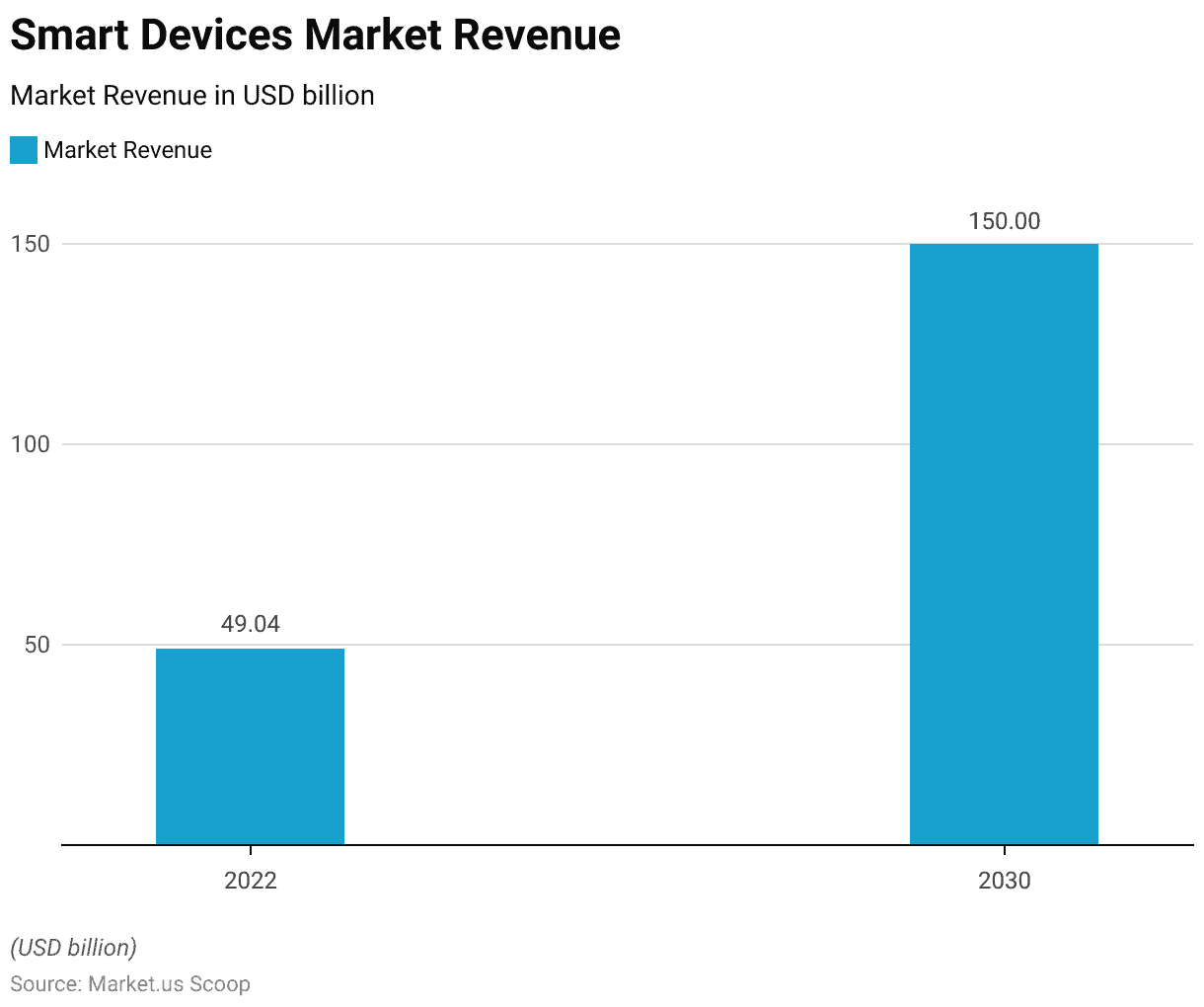
Types of Smarter Devices
Smartphones and Tablets
- Since 2008, the smartphone industry has consistently expanded in market size and the diversity of available models and manufacturers.
- In 2022, the worldwide shipments of smartphones reached approximately 1.2 billion units, although there was a slight dip compared to the previous year.
- As of 2022, an estimated 6.5 billion smartphone subscriptions were actively used, expected to climb to nearly 8 billion by 2028.
- In 2022, the global smartphone usage rate reached an estimated 68%, marking an increase for the first time since 2018.
- Tablet shipments reached their highest point in 2014 and have been on a gradual decline ever since. However, the COVID-19 pandemic led to a slight uptick in tablet shipments due to the increased demand for mobile PC devices for remote work and home entertainment.
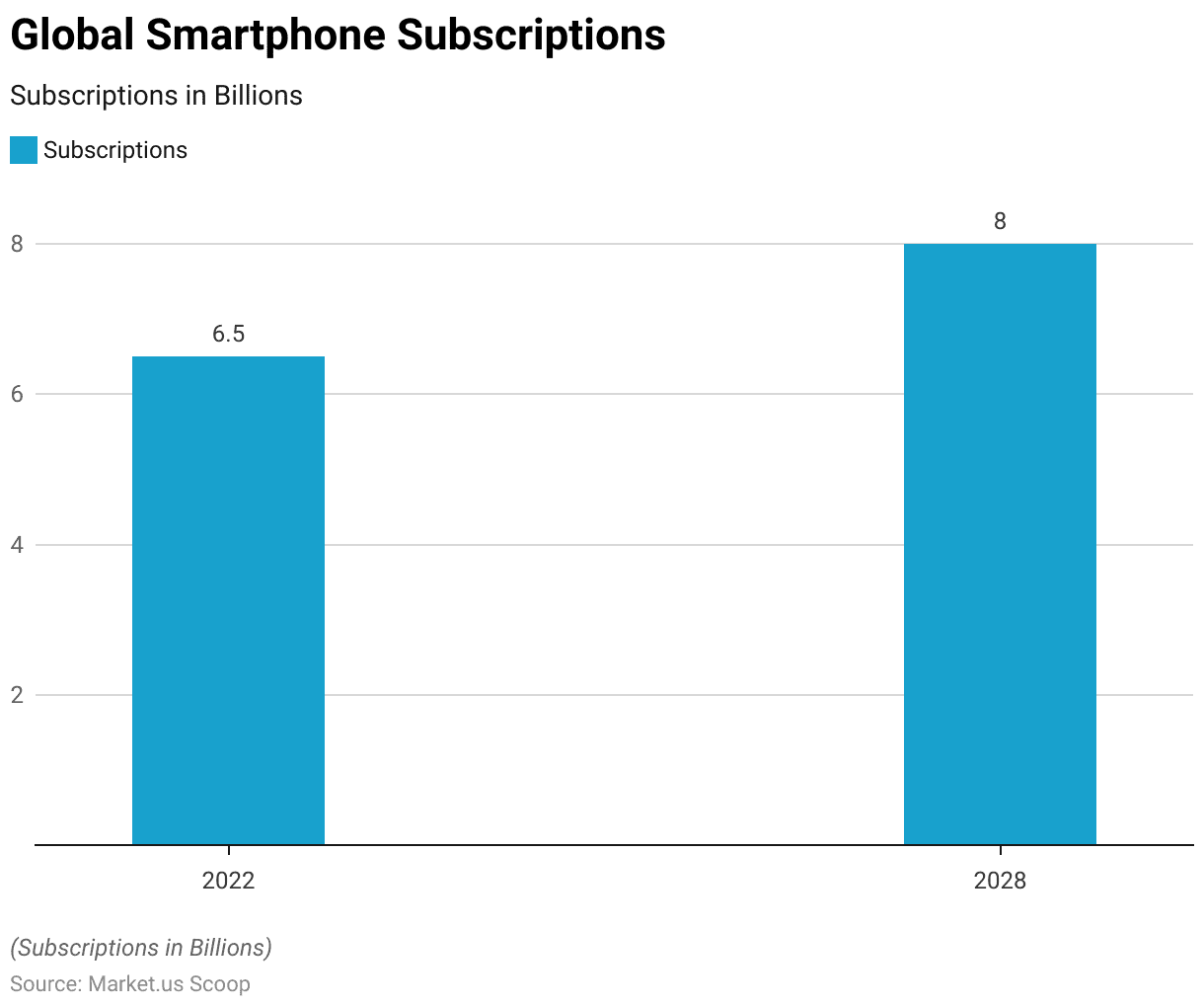
Smart Home Devices
- In 2023, the global shipment total for smart home devices amounted to approximately 857 million units, with a significant portion of these, around 278 million units, falling within the video entertainment category.
- Among the specific device types, lighting is projected to experience the most substantial growth between 2023 and 2027, with a compound annual growth rate (CAGR) of 13.6%.
- Home monitoring and security devices include video surveillance cameras and doorbells.
- Thanks to robust offerings like Google’s Nest and Arlo Pro devices (formerly associated with Netgear), the market for network video surveillance reached an estimated revenue of about 1.1 billion U.S. dollars by the close of 2018.
- Video doorbells, a relatively new segment in the smart home market, are closely related to home security cameras and are expected to see spending rise to 1.4 billion U.S. dollars by 2023.
Wearable Technology
- Wearable Technology Market size is expected to be worth around USD 231 Billion by 2032
- As the name implies, wearables are designed to be worn on the body. These gadgets typically incorporate smart sensors and connect to the internet for data transmission, logging, or analysis.
- Pulsar’s calculator wristwatch can be credited as one of the earliest consumer wearables to achieve global popularity.
- Some noteworthy milestones in wearable technology include the introduction of the first Bluetooth headset in 2000 and the launch of the inaugural GoPro camera in 2004.
- In 2013, Google Glass debuted as the first voice-controlled, optical, head-mounted display offering hands-free internet access, augmented reality features, and image capture capabilities.
- Currently, the most successful wearable devices in the market encompass smartwatches and health/fitness trackers, with the relatively recent category of “wearables” emerging as the dominant player.
- Projections indicate that over 340 million ear-wear units are expected to be shipped in 2023, while smartwatch shipments are anticipated to reach just under 160 million units in the same year.
IoT Devices
- The Internet of Things (IoT) has witnessed exponential growth in connected devices worldwide.
- In 2019, there were 8.6 billion IoT-connected devices, which surged to 9.76 billion in 2020.
- The trend continued with 11.28 billion devices in 2021 and a significant leap to 13.14 billion in 2022.
- Projections indicate even more remarkable expansion in the coming years, with an estimated 15.14 billion IoT devices expected to be connected in 2023.
- As we look further into the future, the IoT ecosystem is set to grow exponentially, with forecasts predicting 29.42 billion IoT-connected devices globally by 2030.
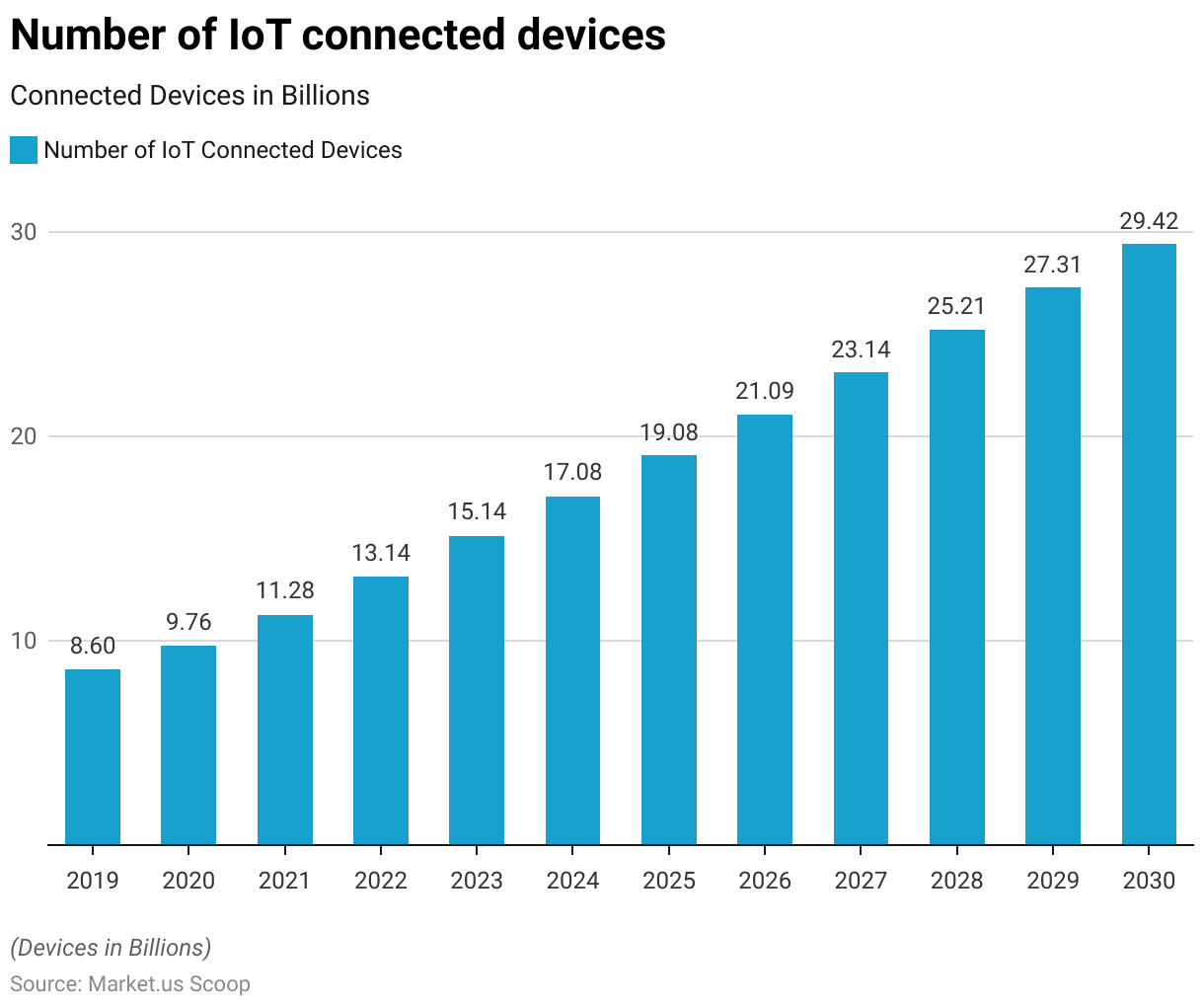
Geographic Adoption Variances
The United Kingdom
- In the UK, smart home products are used by 5.3 million households, representing 19.7% of the total 27.8 million households.
- However, this adoption rate lags behind that of the United States and China.
- The anticipated revenue of the UK’s smart home market in 2022 is £7.85 billion (equivalent to 6.58 billion GBP), with a potential growth rate of around 16%, which could elevate the market’s value to GBP 11.94 billion by 2026.
- During the pandemic, UK households spent a substantial £33 billion on smarter devices as individuals sought to enhance their home experiences while adhering to safety measures.
- Among UK internet users aged 16-64, 24.9% own at least one smart home device, and Ireland also demonstrates a notable percentage usage rate of 22%.
Germany
- Following the UK, Germany emerged as a promising market for smart technology growth. German residents conduct an average of 107,480 monthly searches for smart home products, with “Smart TV” accounting for 90,500.
- According to the German industry association Bitkom, 41% of Germans owned at least one smart home device in 2021, and this number is expected to rise steadily in the coming years, indicating significant growth in the German smart technology market, encompassing nearly 40 million people.
United States
- The United States leads the world in smart home adoption, boasting the highest penetration rate for these technologies.
- In 2022, an estimated 47.4 million smart homes were present in the US out of 140 million households, indicating that nearly 35% of all US homes have embraced smart technologies.
- This marks a significant increase of approximately 17.9 million households compared to 2018, underscoring the steady growth of smart homes in the US.
- Smart home sales in the US will reach USD 47 billion by 2025, double the sales recorded in 2020.
China
- China ranks as the second-largest market for the growth of smart home technology, boasting 68 million smart households within a total of 500 million households in the country.
- China’s smart home technology market is poised for substantial expansion, with an anticipated revenue surge of USD 23.63 billion in 2022.
- The revenue generated by smart home products exhibits consistent growth at a rate of 15.8%, ultimately leading to a projected market size of $42.6 billion by 2026.
- Chinese homeowners focus on connectivity, comfort, and lighting through smarter devices.
- Projections indicate that by 2026, the number of active smart households will reach 142 million users.
User Behavior and Preferences
User Investment Preferences
- People increasingly invest in various smart home applications to enhance their living environments.
- Among the categories, “Home Security” emerges as a top priority, with 55.56% of individuals planning to allocate funds to bolster their home’s security measures.
- Following closely, “Management of Household” garners significant interest, with 52.63% intending to invest in technologies that streamline household management tasks.
- “Energy Efficiency” also holds appeal, with 35.29% of respondents seeking to make their homes more energy-efficient.
- “Entertainment” and “Healthcare & Wellness” draw investment from 35.29% and 33.33% of participants, respectively, indicating a desire to incorporate technology into leisure and well-being.
- “Home Décor & Comfort” and “Personal Assistance” round out the preferences, with 25% and 22.58% of respondents willing to invest in these areas, respectively.
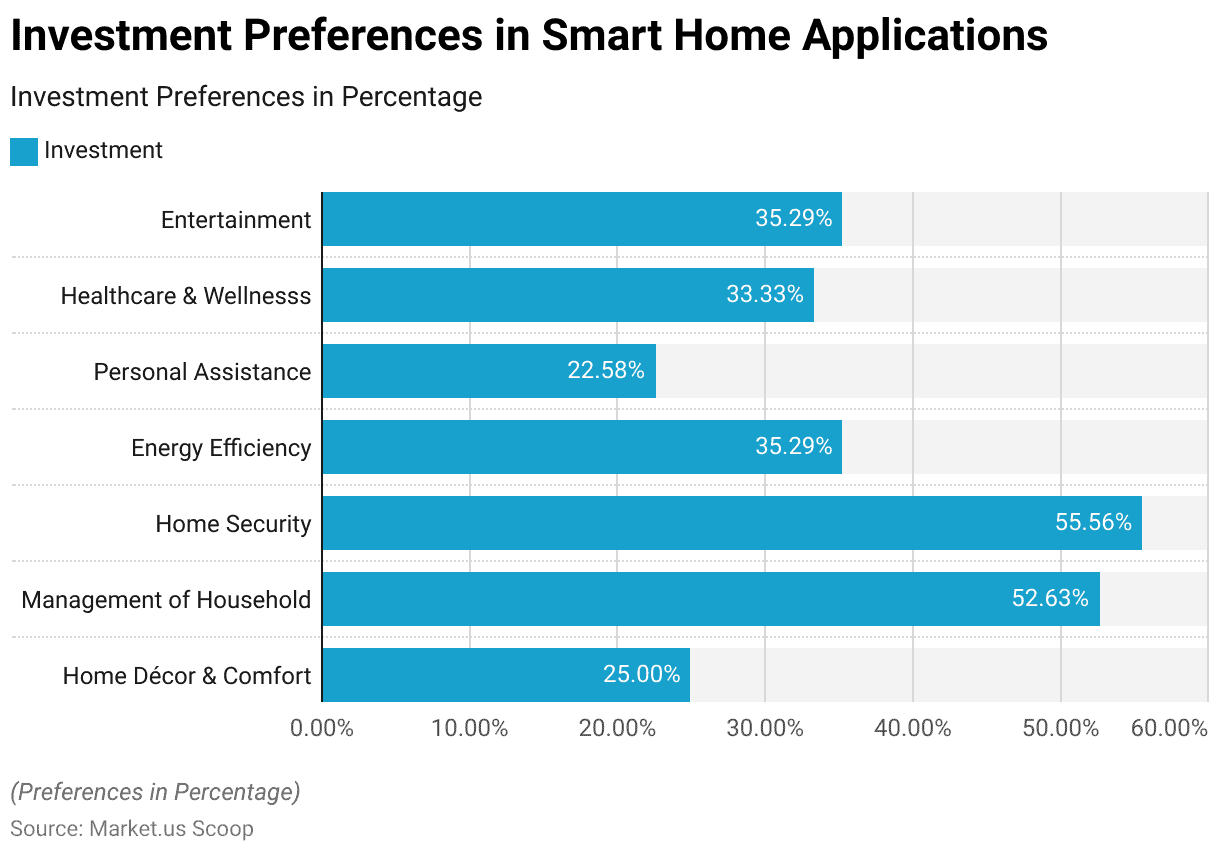
Smart Device Ownership by Age Group
- Ownership of smart home devices varies significantly across different age groups.
- Millennials lead the pack, with 64.71% of individuals in this age bracket owning smart home devices.
- Gen X, the generation that came before them, also demonstrates a considerable interest in smart home technology, with 50% adopting these devices.
- In contrast, Gen Z, the youngest cohort, currently shows a lower ownership rate at 25%.
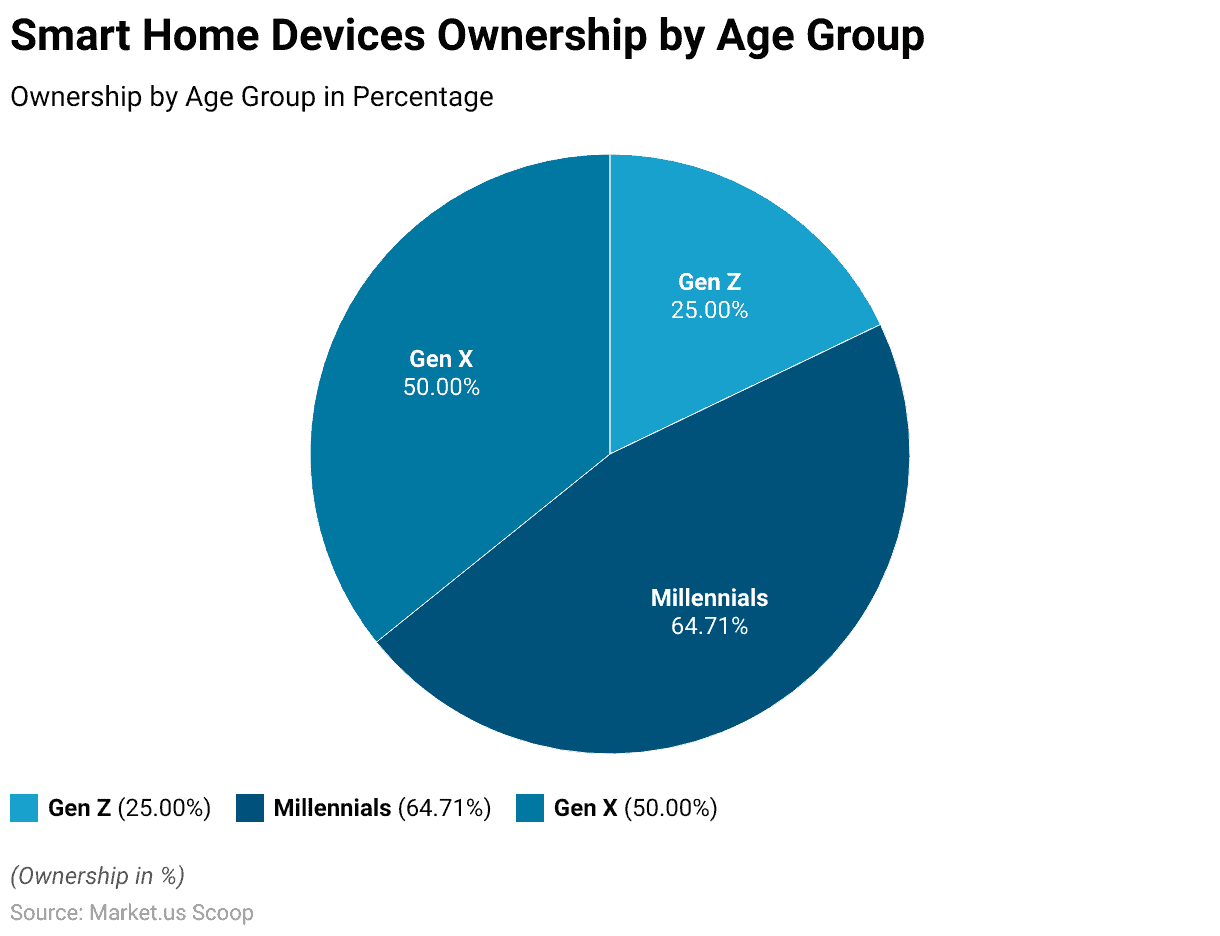
Popular Smart Device Preferences of Users
- Smart Appliances Market size is expected to be worth around USD 150 Billion by 2032
- Regarding user preference for smart home device brands, there are a few standout choices.
- Nest leads the pack, with 37.5% of users expressing a preference for their products, closely followed by Amazon at 36.46%.
- Philips Hue and Samsung share an 8.33% preference rate, indicating moderate interest in their offerings.
- Ring, known for its home security solutions, captures 7.29% of user preference.
- Ecobee and Kasa, though garnering less attention, still have their share of enthusiasts, with 3.13% and 2.08% of users favoring them, respectively.
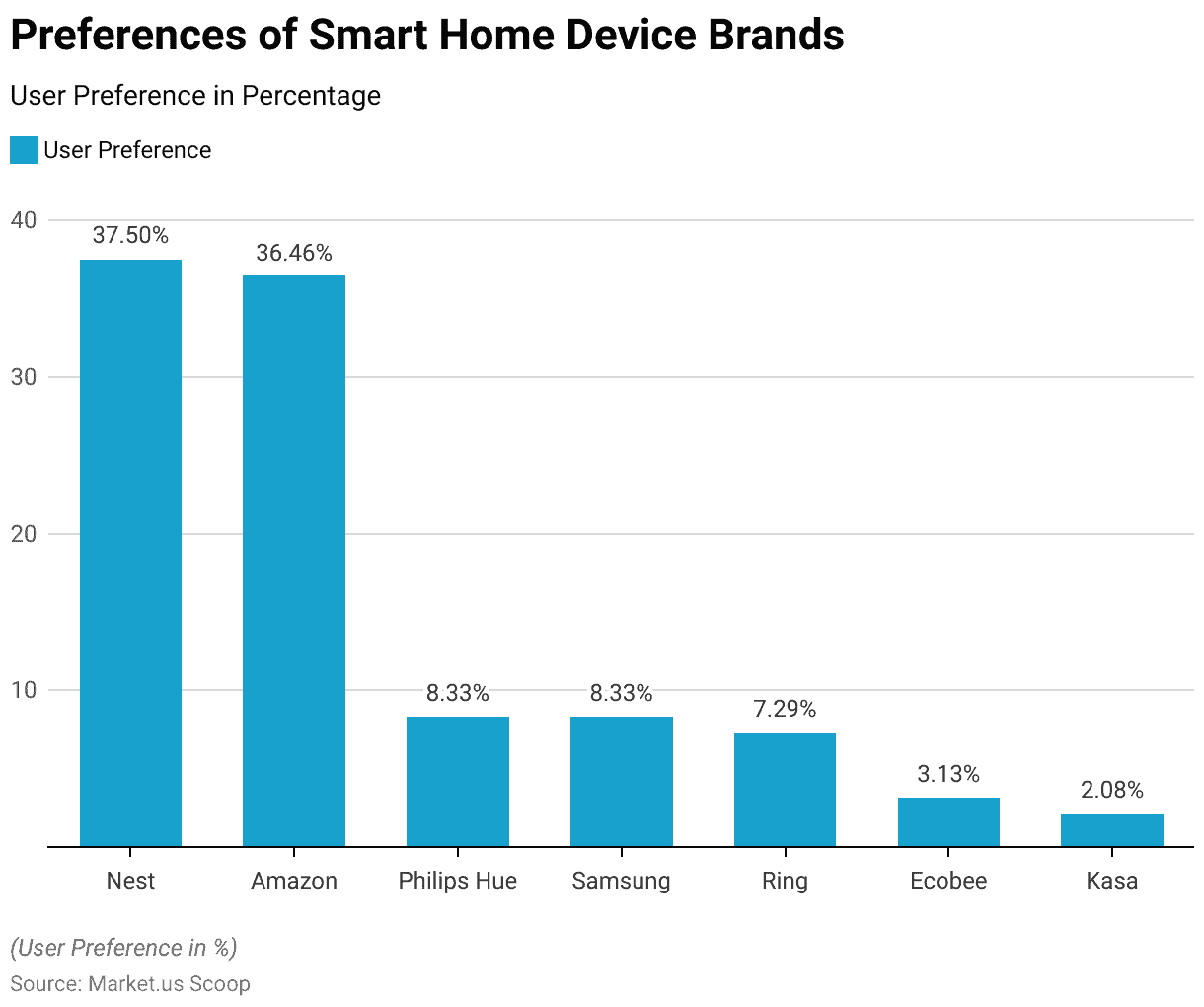
Key Features and Technologies
Artificial Intelligence (AI) Integration
- Currently, 35% of businesses have adopted AI, with 42% considering future AI implementation.
- Gartner’s report forecasts the global AI market to reach around $266.92 billion by 2027.
- In 2020, the U.S. saw over 10 million active voice assistant installations.
- McKinsey & Company suggests AI could add a significant $13 trillion to the global economy by 2030.
- Healthcare widely embraces AI, with a $6.6 billion market in 2021.
- By 2030, up to 30% of jobs may be automated through AI.
- The global AI market in education is projected at $3.68 billion by 2023.
- An MIT Technology Review survey finds that 81% of business executives see AI as a major competitive advantage.
Connectivity and Communication Protocols
- The global Control and connectivity market is on track to reach a revenue of approximately US$23.3 billion in 2022.
- This industry is primed for substantial expansion, with an expected annual growth rate of 12.01% (CAGR 2022-2028), resulting in a projected market size of US$48.9 billion by 2028.
- Regarding active households, it’s foreseen that the Control and connectivity market will encompass roughly 643.4 million households by 2028.
Concerns Related to Adoption of Smarter Devices
Privacy Concerns
- Data security is a significant worry for consumers, as demonstrated by research carried out by Parks Associates.
- Their findings reveal that 49% of individuals who utilize connected devices have faced at least one data security or privacy issue.
- Additionally, almost 75% of households exhibit various levels of concern, with many expressing a high degree of worry regarding spyware or viruses on their smarter devices.
- According to Parks Associates consumer data, the typical number of connected devices in households is 16, and individuals who own smart home devices generally possess an average of eight such devices.
Security Concerns
- According to research by Parks Associates, 72% of consumers express varying levels of concern, with many being very concerned about the security of their data collected and transmitted by devices.
- They also harbor concerns about unauthorized access or control of their smarter devices.
- Among users of smart home devices, 55% of consumers worry about the potential for hackers gaining access, while 39% have concerns about technology companies gaining unauthorized access.
Discuss your needs with our analyst
Please share your requirements with more details so our analyst can check if they can solve your problem(s)



